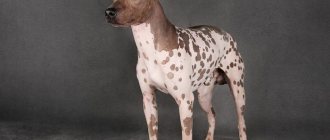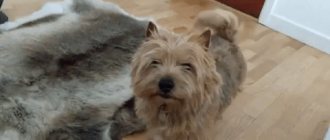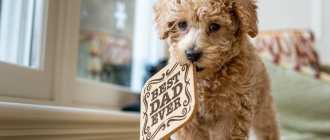The Tibetan Terrier, which attracts attention with its shiny, elongated coat, separated by an even parting in the upper body and on the head, although outwardly reminiscent of indoor Yorkies, belongs to a different group of dogs. The breed, which has existed for more than 2 thousand years, has changed little, since it was bred in mountainous areas inaccessible to people, and was recognized by international organizations only in 1956.
Origin story
An interesting fact is that Tibetan terriers are not actually such. They were called terriers by Europeans who visited Tibet and China, since the animals’ appearance reminded them of familiar terriers.
The main version of the origin is the one that talks about the temple affiliation of dogs. Monks were engaged in breeding, believing in the holy essence of animals and their ability to ward off evil spirits and protect the home from them.
Among the population, it was considered a special honor to receive such a talisman in the form of a Tibetan terrier, which spoke of the special approval of the gods and promised protection from dark forces.
For a long time, terriers were prohibited from being exported outside the country. For such a crime the death penalty could be imposed. The first individuals were exported at the beginning of the 20th century, but this was only possible if the puppy was donated directly by the monk. Such a gift was given only as special respect or gratitude.
The first association of breed lovers was founded in England by the doctor Agnes Greig, who received several Tibetan terrier puppies as a sign of special gratitude for saving the life of the wife of a Tibetan rich man.
It was in England that Tibetan guests received the name terriers, while in their homeland they were called Tibetan apsos.
Official recognition occurred in the second half of the 20th century, but it is still considered small and rare. Interestingly, in their historical homeland there is no longer a ban on the export of Tibetan terrier puppies from the country. In addition, the monks give babies to those tourists who were able to overcome dangerous mountain heights.
Photo: flickr.com
Chongqing
One of the oldest Chinese breeds on the planet. There are many sculptures of the dog in the tombs of ancient emperors. Chongqing people idolize their master, but they treat strangers with great caution. It is better not to keep such a dog with other dogs, and they generally hate cats. They treat children well; they can be safely left with even the smallest children.
Their diet should not consist of dry food, only natural products. Life expectancy is 19-20 years .
Description of the breed
The appearance of long-haired Tibetans leaves no one indifferent. They are muscular and hardy, but due to their thick coat this is not always noticeable. This physique allows you to overcome steep mountain slopes, rocky areas and plains.
Tibetan terriers have clearly expressed sexual dimorphism: males are always more massive and larger than females. But the coat is the same in both sexes: long and thick, with an insulating short undercoat.
The color of dogs can be white, gray or creamy black. Almost any color is acceptable, except liver.
Standard
The latest breed standard was published in 2011. It includes indicators:
- height of males 36-41 cm, females 32-39 cm;
- weight of males 9-13 kg, females 7-10 kg;
- the head is small, the fur falls over the eyes, but does not interfere with looking;
- the jaws are well developed, the hair grows on the lower part, forming a beard;
- scissor bite shape;
- small muzzle;
- the nose is black or matches the color type;
- the eyes are round, brown with black eyelids;
- the ears droop, the fit is loose, they are hard to see because they are covered with hair;
- medium length tail set high;
- limbs are well developed;
- the coat is straight or wavy, but does not form a steep curl;
- life expectancy 12-14 years.
All deviations from standard indicators can be considered a disqualifying feature or defect, the severity of which is calculated in each specific case depending on the degree of severity.
Photo: wikimedia.org
Appearance
A medium-sized breed of square format with strong, harmonious, fairly strong, but not heavy bones. The muscles are powerful, but not dry. The skin is tight-fitting. Too heavy, rough, loose bones or muscles are serious shortcomings; great attention is paid to the harmony of the physique. At the same time, representatives of the breed have a clearly defined sexual type. Males are more powerful, fluffier, stockier than females. When judging, the build of male dogs is standardized more strictly. An elongated body shape is considered a disadvantage. Paws that are too high or a long or arched back are considered a fault.
Similar breeds
Although Tibetans are not terriers, but were bred more as herders, they are very similar in appearance to many terriers.
Bobtail
Outwardly, these dogs are very similar. The main difference is in size - the bobtail is noticeably larger, and its coat is much fluffier and thicker. The Tibetan looks like a dwarf bobtail.
Black Terrier
Outwardly they are very similar, but, as in the previous case, they are very different in size. Additionally, the Black Russian Terrier's coat may have a noticeable curl. The only acceptable color is black, while the Tibetan Terrier has a wide range of colors.
Shih Tzu mix
To obtain designer dogs, breeders also breed Yorkshire Terriers and Shih Tzus. Puppies born as a result of such crossing are called Shorkies.
Distinctive features of these dogs are their compact size, wide but cute muzzle and body type, reminiscent of a Shih Tzu.
Most individuals have the same color as the Yorkshire Terrier, but some individuals have spots of different shades on the coat.
Character and behavioral characteristics
A characteristic feature of his character is his great friendliness and flexible nature. Dogs of this breed are devoid of aggression. Get along well with other pets. They are perfect for family life because they adore children.
Despite the fact that the dog will never bother the owner and constantly hover under his feet in order to beg for attention, such a pet cannot be left alone for a long time. Adult dogs tolerate the period of absence of the owner very poorly, especially if foster care is organized with strangers or in a kennel. Change of owner is very painful.
Tibetan Terriers can be called intellectuals. They love various activities, outdoor games and, oddly enough, rules. It will be interesting for such a dog to learn and remember the new requirements of the owner and follow them for the rest of his life.
The breed is considered absolutely problem-free in terms of education. Only the wrong approach and late socialization can turn this good-natured dog into an ill-mannered and aggressive dog.
Photo: wikimedia.org
Shar Pei
Researchers believe that Shar-Peis are related to short-haired Chow Chows because their tongues have a bluish tint. These dogs are smart, majestic, and love to take care of children. In China, Shar Peis are used to rehabilitate children with mental disorders.
Their “wrinkled” faces do not leave anyone indifferent, but do not be misled; these dogs are very brave and are ready to protect their owner at the cost of their own lives. In a family they choose one owner, and they even tend to be jealous of other family members.
Unfortunately, this is one of the most difficult dog breeds to care for; they are prone to a large number of genetic diseases.
Full description: Shar Pei
Education and training
Training and accustoming to the rules of life in the house must begin from the age of three months. The baby will need to be taught to:
- collar;
- walks on a leash;
- street sounds and other dogs;
- cars and strangers;
- prohibition of picking up objects on the street.
Training begins with the baby getting used to the nickname, then they teach the simplest commands: “come to me,” “fu,” “place,” “sit,” “lie down.”
A typical lesson should not exceed 30 minutes; as you get older, it can be increased. We must not forget about encouragement and the possibility of alternating learning and play.
You cannot use physical force or a loud voice. Having frightened the puppy once, it will take a lot of time to earn his trust and begin training again in a calm environment.
See how training happens.
Japanese Chin
Despite their name, these dogs were bred specifically for the Chinese imperial house and were subsequently presented by Tibetan monks to the Emperor of Japan. Despite the mischievous look, chinas are very secretive and cold, they demand respect and admiration. The Japanese Chin does not tolerate loneliness and is prone to jealousy.
Chins get very lost in unfamiliar surroundings, so it is better not to leave them alone so that the dog feels the support of its owner.
Full description: Japanese Chin
Diseases
Tibetan Terriers have excellent health and are long-lived. Quite often they live up to 15-18 years, but this is only possible with proper care and timely consultation with a doctor for treatment.
The breed is predisposed to diseases:
- obesity. You will need intense physical activity and a balanced diet;
- diseases of the musculoskeletal system;
- eye diseases;
- heart rhythm disturbance;
- otitis.
Most of these diseases develop in Tibetan terriers with age. No obvious genetic pathologies were identified. Timely vaccination and preventive treatment against parasites are necessary.
Pekingese mix
Mixed breeds of Yorkshire terriers and Pekingese (Yorkinese) have a very pretty appearance, complemented by an aristocratic character, but they are quite rare, because these dogs have fragile health.
It is also absolutely impossible to predict what the puppies resulting from such crossing will be like, because the best qualities of their parents are not always passed on to them.
Often an undesirable mixture of characteristics is found in puppies, which is determined by poor coat, squinting eyes, an unformed skull, a non-closed fontanel and other problems.
Care
Tibetan Terriers are unpretentious dogs that have the ability to adapt to any conditions. But their long coat, which falls almost to the ground, needs special care. It is necessary to comb the coat daily, using only a special brush with iron teeth. Combing is done along the hair growth.
If your pet's fur is dry, do not brush it. It’s better to wet it a little with a spray bottle and add a special conditioner to the water.
Dogs are bathed frequently because long hair gets dirty quickly. When swimming you need to follow the rules:
- shampoo is not rubbed into the animal’s skin, only into the fur;
- A wet dog is dried with towels; a hair dryer should not be used.
Grooming the Tibetan Terrier is recommended twice a year, that is, every six months.
The breed is suitable for allergy sufferers and lovers of cleanliness - the dogs do not smell like “dog” and practically do not shed.
You will need to pay attention to the animal’s eyes, especially at a younger age. They are wiped with a swab dipped in water or a special lotion several times a week. The hair around the eyes is trimmed neatly.
Tibetan Terriers suffer from frequent ear infections, so periodic ear examinations and hygienic cleaning are necessary.
If necessary, trim the nails and trim the hair between the toes.
Note that the teeth of Tibetan terriers are often covered with tartar and caries can develop. Regular inspection and cleaning with special pastes is necessary.
Photo: wikimedia.org
Content
The ideal conditions for keeping a pet would be a spacious enclosure with a warm kennel or a closed local area with the ability to hide in an equipped kennel. Keeping the dog in a spacious house or apartment is also suitable, but in this case you will need to walk the dog regularly twice a day.
Important! You need to walk your dog for at least 2-3 hours every day, and preferably more. Otherwise, damage to the animal owner's property may be caused.
Feeding is another important aspect of keeping a pet. Due to the large admixture of wild wolf blood, animals of this breed are not adapted to balanced dry food. It is better to use natural feeding with meat and protein products. Nutrition must be competent and balanced so that the pet receives all the necessary vitamins and microelements.
The Chinese German Shepherd is a separate breed, recognized in the country in 1988. They are noticeably different from their purebred relatives, but at the same time they have many similar traits.
Feeding
The basic rule of Tibetan nutrition is a complete ban on food from your table. Such feeding and treats will lead to the development of obesity and gastritis. For an adult dog, it is better to choose a balanced premium ready-made diet.
As for the baby who has just been separated from his mother, it is better to choose natural food with sufficient calcium content. This means that the baby’s menu should include a lot of low-fat fermented milk products.
Basic rules for creating a natural diet:
- diet: puppies should receive food 7 times a day, adult dogs 2 times;
- overeating should not be allowed;
- the basis of the diet should be lean meat (beef, poultry) and offal;
- The diet should include cereals (rice, buckwheat, oatmeal), vegetables and fruits (both raw and stewed);
- The diet should not contain sweets, smoked meats, potatoes, corn, legumes, or sharp tubular bones.
It is useful to give your dog beef bones or special store-bought bones to cleanse the teeth of deposits.
Photo: pixabay.com
Pet food
Nutrition is an important part in a dog’s life, because it affects its health. It should be natural and balanced; the age, weight and height of the dog also play an important role.
The diet must include the following products:
- lean meat
- fish fillet
- porridge
- vegetables
- dairy products.
The exception is potatoes, any baked goods, fatty foods and bones.
Tips for choosing puppies
You can only get a healthy puppy by contacting a professional breeder. In this case, you will know the baby’s pedigree, he will have the necessary vaccinations and treatments. Breeders often do a series of tests to rule out genetic pathologies.
When choosing a puppy, pay attention to his eyes and nose - there should be no discharge. Talk to the breeder - by the time of sale, they know the character of each baby from the litter and will be able to recommend a pet that suits your temperament.
Look how the puppies are frolicking!
Price and where to buy a puppy
We recommend buying small Tibetan terriers only from a kennel . Markets and newspapers can entice with low prices, but in this case there is no guarantee of purchasing a healthy pet. In addition, there is a great possibility of acquiring a mixed breed or a dog that is simply similar in appearance.
The cost of the baby will depend on:
- popularity of the nursery;
- pedigree;
- exhibition prospects.
The usual cost varies between 25-50 thousand rubles. Due to the rarity of the breed, you will have to book a friend in advance and additionally pay for delivery from the country where the nursery is located.
Price policy
The Tibetan Terrier is a common dog breed, so you can buy one without any problems. If you want a dog for visits and participation in competitions and exhibitions, then it is better to buy it in a specialized nursery, with documents.
And if you want her to just run around in the yard, then you can buy it cheaper on the Internet, on special sites for animals.The general price of a Tibetan Terrier is about $560. It is best to buy it at a young age to show who is boss in the house.
Owner reviews
Vlad K.
Surprisingly, the little dog turned out to be a serious guy. I tried to push my authority as the owner, so designate the head of the house from the very beginning. Very active dogs, they can run around with children all day long. The children are already asleep, but the dog is still ready to walk and play.
A family dog, absolutely everyone is delighted with her: the children, me and my wife, who was not very happy about having an animal in the house.
Irina S.
My daughter gave me a dog. A pet in the house is very disciplined - you need to take a walk, think about food for it. The dog is small and doesn’t appeal to me much on the street. You can also let him go, he doesn’t run away and doesn’t bully other dogs. Security guard - barks at all strangers. It’s not scary at home with him; from behind the door it seems like the dog lives in a decent-sized house.
Mating
To obtain offspring, it is better to contact a kennel club. Both the female and the male must have show grades that are sufficient for breeding.
The first mating can be carried out when the female has reached the age of 1.5 years, and the male has reached 1 year. But it is still better to postpone mating until the age of 2-2.5 years, because that is when the body reaches full maturity.
Important! You can introduce a couple on a walk, but for mating you should prefer the territory of the male.
The breed should be prepared in advance for mating by choosing a high-quality pair
Briefly about the main thing
- The Tibetan Terrier is an ancient breed of dog that is not related to terriers;
- Belongs to the number of small and rare;
- The coat needs daily care and trimming every six months;
- They are unpretentious in feeding;
- There are no obvious genetic pathologies;
- A puppy costs from 25 to 50 thousand rubles.
Which of our readers has a Tibetan terrier? Let's talk about them: temperament, feeding and care. Share your experience in the comments, please.
Did you like the article? Share it with your friends on social media. networks. This will help them get useful information and support our project.
Lhasa apso
The breed has a thousand-year history, its homeland is the mountains of Tibet, the strong legs of these dogs miraculously climbed mountains, and a good coat protects them from cold and heat.
Apso are extremely distrustful of strangers, sense danger from afar, and in difficult situations can make their own decisions.
It is not easy to train such a dog; due to their suspiciousness and independent nature, it is very difficult to find a common language with them. Obedience can only be achieved by acting persistently, but very gently; it is very important to establish clear discipline.
The coat of the Lhasa Apso is an indicator of proper nutrition; if the diet is incorrect, the coat immediately becomes dull and falls out.
Full description: Lhasa Apso
Exterior
There are 2 types of German Shepherds in China. They are completely different in appearance, although a certain similarity can be seen in them, because their ancestors are still the same German shepherds.
There are two types of “Germans” recognized in the PRC:
- Kunming (a light and nimble dog that perfectly shows its working qualities, has a light frame with a fairly high height at the withers, about 65 cm, the dog weighs about 35 - 37 kg, by color they distinguish between saddle-backed, zoned and almost black pets);
- German Shepherd of Chinese breeding (large animals with a massive head, their weight can reach 70 kg; there is a version that in their blood, in addition to the base from German shepherds, there are impurities from the Tibetan mastiff).
Important! The first variety shows itself well in operational and rescue activities, the second variety is an excellent guard, somewhat slow, but no less formidable.
Adults
In appearance, the Chinese-bred shepherd resembles a “German” crossed with a mastiff. It has a large head, a shorter muzzle with a non-pointed nose, a powerful and wide chest, and stronger paws. The animal is slightly heavier than its purebred relatives, and slower. However, its large size and intimidating appearance make it possible to effectively use it as a security guard.
From the usual shepherd dogs, the dog has erect ears, in most cases a sable-colored coat with a dense undercoat. The tail is saber-shaped and droops down. The back and croup are wide, powerful, the angles are sharp and pronounced.
Puppies
Shepherd puppies bred in China differ little from purebred “German” babies. Almost all of them are born almost black in color and in the first month they are almost no different in size and power from their relatives from Germany.
A little later, the babies acquire angular outlines of the muzzle, the head and body become powerful, and the clear outlines of mastiffs, whose blood is mixed with this breed, become visible. The color of the coat becomes black by 2-3 months and subsequently remains virtually unchanged.
Tibetan mastiff
The dogs are very strong and powerful in build. Mastiffs are very calm and silent animals, they have a very intelligent, philosophical look.
Tibetan Mastiffs are a little phlegmatic and never push themselves with games. Psychological maturation ends only by the age of four. They love children very much and treat them with care, as if they were their own puppies. It is difficult to raise them, since they are stubborn, they need to be treated like little children, and obedience is stimulated with treats.
Despite their impressive size, these dogs eat little and are not picky about food, the main thing is that they have round-the-clock access to water.
Full description: Tibetan Mastiff
Tibetan Spaniel
These dogs can become both guard dogs and companion dogs. Spaniels are completely non-aggressive, and love their family very much, but they are wary of strangers.
Unfortunately, this breed has a genetic predisposition to discopathy and allergic dermatitis, so you need to be very careful when preparing your diet.
During training, the main thing is to show patience and perseverance; if you show physical force to the dog, then trust will be lost forever.
Full description: Tibetan Spaniel
Taiwanese dog
This is a multifunctional breed of working dog. For a long time the breed existed in a semi-wild state, many times it was on the verge of destruction, but each time it was restored.
There are three height varieties of dogs: 30cm, 40cm, 50cm, the latter being the most popular.
These dogs are very energetic and can show aggression towards strangers, but in the event of a stressful situation, their psyche suffers greatly and they need several days to recover.
Despite their high intelligence, it is difficult to train these dogs; they are too independent and stubborn, they can openly ignore the owner’s commands. However, if a common language was found, then the dog will be a true friend.
Full description: Taiwanese dog











